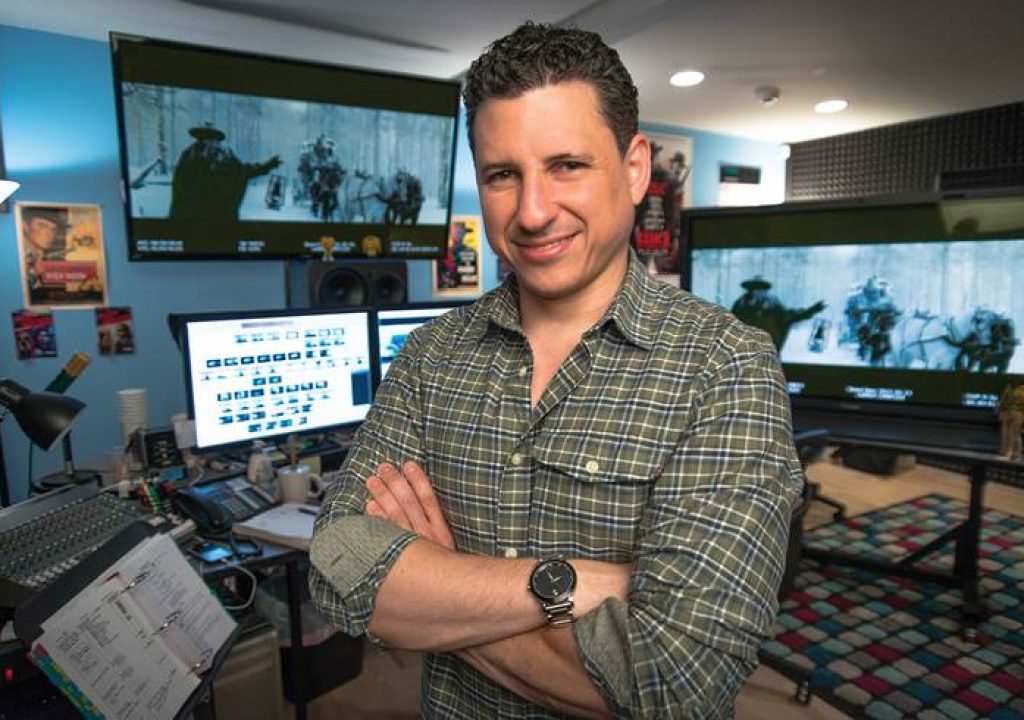Fred Raskin, A.C.E. has edited a number of great projects including 2014’s “Guardians of the Galaxy” and “Fast and Furious.” As an assistant editor, he worked on both of Quentin Tarantino’s “Kill Bill” movies before moving to Tarantino’s coveted editor chair with “Django Unchained.”
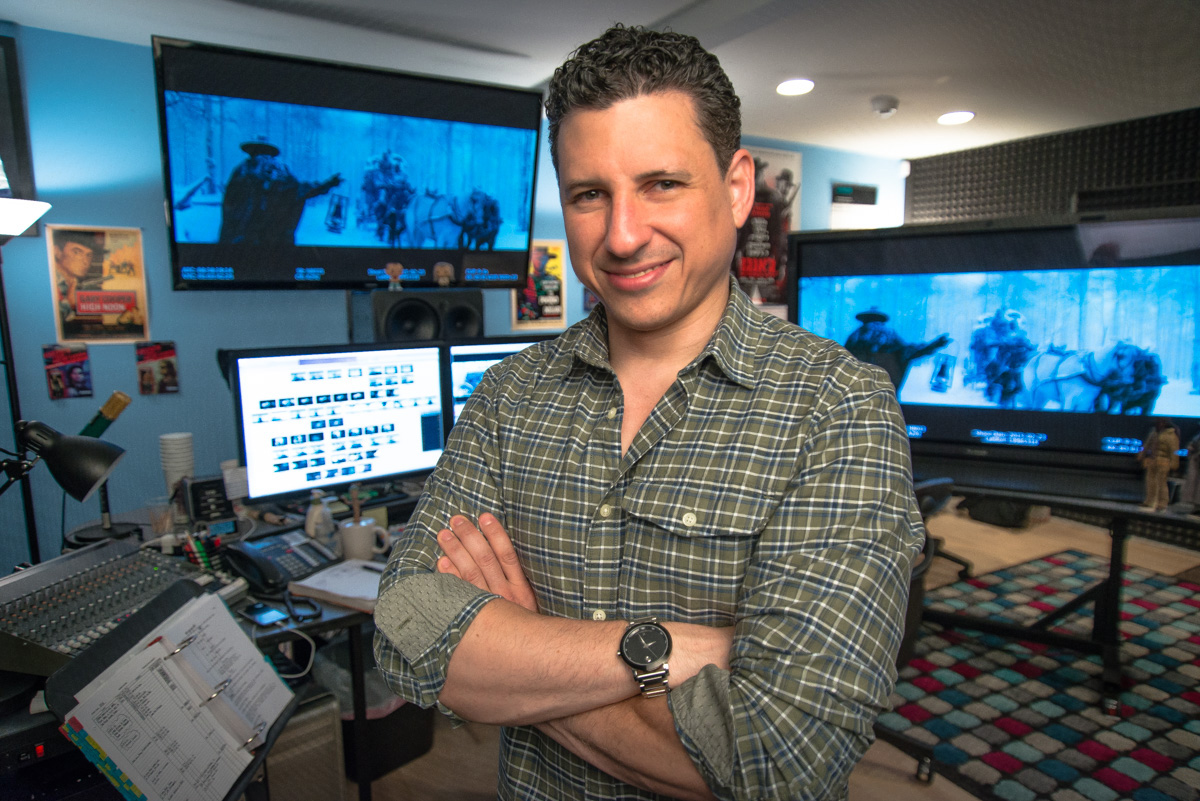
Fred Raskin, A.C.E. has edited a number of great projects – solo or as co-editor – including 2014’s “Guardians of the Galaxy” and “Fast and Furious.” As an assistant editor, he worked on both of Quentin Tarantino’s “Kill Bill” movies and created a working relationship (which you’ll soon read about) that launched him from assisting Tarantino’s longtime editor, Sally Menke, to the coveted editor’s chair with “Django Unchained.” (He had edited many projects for other directors prior to “Django.”) The extended filmography includes: Hateful Eight, Bone Tomahawk, Guardians of the Galaxy, Django Unchained, Fast Five, The Big Bang, Fast and Furious, The Lazarus Project, Fast and Furious Tokyo Drift and Annapolis.
One of the major talking points about this movie has been the fact that it was shot in “glorious 70mm” and would have a Christmas “roadshow” across the nation during which, it would be shown in 70mm. Early next year, a re-cut and cut-down version will play digitally in cine-plexes during a standard release. I would have to say that the quality and “scope” (pun intended) of going seriously old-school with the acquisition format certainly played into my enjoyment and perception of this movie as a very special entity. The aspect ratio really hasn’t been seen since the 1960s: 2.75:1, and it was a different movie experience to see something in that ratio for me. For comparison, HD is 1.78:1, and even what most consider as “very wide” is still only 2.39:1.
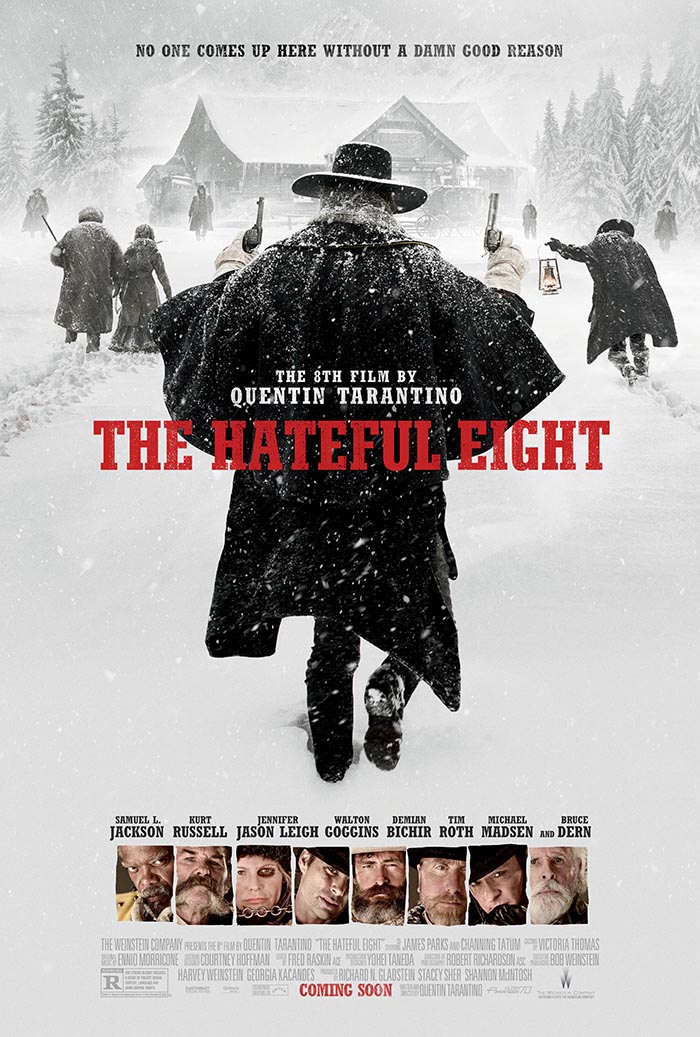 As a moviegoer, I noticed that the film was long (3 hours 2 minutes plus an intermission). As a scriptwriter, I notice that the scenes are long (more than six TIMES the length of a typical Hollywood movie). And as an editor, I noticed that the shots are long (one runs over four minutes which is about SIXTY times longer than the average shot length – 4 seconds – of a typical modern movie). But, as I told Raskin, despite these extended lengths from the macro to the micro, the pacing felt right.
As a moviegoer, I noticed that the film was long (3 hours 2 minutes plus an intermission). As a scriptwriter, I notice that the scenes are long (more than six TIMES the length of a typical Hollywood movie). And as an editor, I noticed that the shots are long (one runs over four minutes which is about SIXTY times longer than the average shot length – 4 seconds – of a typical modern movie). But, as I told Raskin, despite these extended lengths from the macro to the micro, the pacing felt right.
HULLFISH: How did your relationship with Quentin evolve? I know you were the assistant editor on the two “Kill Bill” movies. How did you end up as the editor on “Django” and this film?
RASKIN: I was an assistant on the “Kill Bills” and would see Quentin regularly over the years that followed at his theater, The New Beverly Cinema, and we’d always talk and he knew that I was a movie editor and I think he felt in me kind of a kindred spirit and so when they did their rough cut of “Death Proof” Sally (Menke, editor) called me and said, “Quentin wants to invite you to our screening.” When they finished the rough cut of “Inglorious Basterds” I got a phone call from Quentin one day and we are trying to get it in shape for the Canne Film Festival, can you come in and take a look on it in the Avid. And I said, “You’re putting me in a horrible position because there’s no movie – as a Jewish guy – to which I’m more looking forward than ‘Inglorious Basterds’ and you want me to watch it for the first time on a 35″ standard definition TV screen?” And Quentin responded, “I feel your pain. However, the potential will be there for you to have an actual impact on the movie.” I just laughed and said, “I wasn’t actually going to say no.” So he kept me involved and in the family in that way, and when he finished the screenplay for “Django” he called me to tell me that he had a copy for me and I didn’t actually think anything of it at the time. It was the same as him inviting me to a rough cut screening, but I read the screenplay twice and wrote him a long, gushing email and told him just how much I loved it and said, “I know you’re going to have every editor in Hollywood knocking at your door to let them edit your movie, so I figured I’d be the first. I have significantly less experience than a lot of people in Hollywood, but I will work harder than any of them.” He wrote me back the next morning and he said, “Thanks for the email. I’ve actually been thinking of having you do this with me. I’m in New York for the next week, but let’s talk when I get back and don’t take any other jobs.” That was one of the most thrilling emails I’ve ever received. I was definitely on the moon when I got that.
the-hateful-eight-HatefulEight_Clip_GotRoomForOneMore_Rev_h264_hd from Steve Hullfish on Vimeo.
HULLFISH: Let’s talk about pacing with this aspect ratio and size image. With the width of the screen and the detail and beauty in the images, I felt like my eyes really needed time to drink it all in on each shot. Did that affect your pacing?
RASKIN: Yes. Absolutely. Because of the clarity of the images, along with the beauty of the compositions, if there were moments where we didn’t need to cut, we wouldn’t. And frequently the question became, “What is the most impactful place to cut?” Because you’re holding on an image that is so stunning and you can see the depth of the performances in the characters’ eyes. Cutting away, it didn’t seem like we were going to gain anything from it. So we would have to be very careful about only doing when it was going to have maximum impact.
HULLFISH: I thought the pacing was beautiful. But it did feel like you were on shots for a long time… it felt RIGHT that you were on them for a long time…
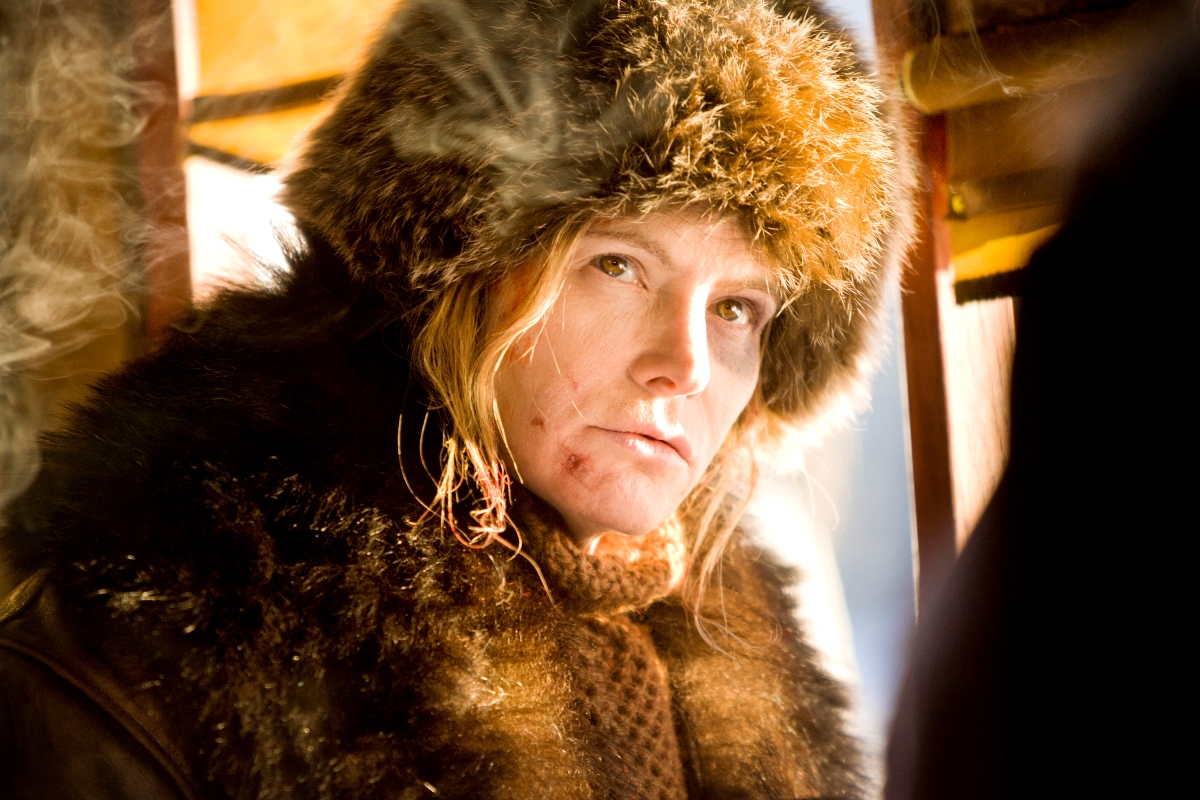 RASKIN: Well, I’ll tell you something interesting. In the 70mm version, the sequence where Daisy plays guitar?
RASKIN: Well, I’ll tell you something interesting. In the 70mm version, the sequence where Daisy plays guitar?
HULLFISH: Oh yeah. I was going to ask about that. The whole song plays on a single shot of her playing with stuff going on in the background behind her.
RASKIN: That’s a four and a half minute take. In the 70mm version that you saw, that’s the way it plays out. When we watched that shot in 70mm it was like “Why do we want to go anywhere else?” But Quentin shot coverage of that scene and in the digital version we did actually use some of the coverage. There’s a different cut for that version because the feeling was that if we’re not seeing this in glorious 70mm, then maybe the image doesn’t have quite the same amount of power and it’s OK to use some of the other coverage on that scene. So that scene is different in the multi-plex, digital version that is coming out on January 8th.
HULLFISH: Tell me about your edit suite… I’d think you’d want to watch this on the biggest screen possible as you were editing. I talked to Alan Bell and he said he edits using a very large, projected image.
RASKIN: I have two 60″ monitors, mainly because I have one above my source/record and bin monitors and Quentin has another, which is off to the right. Mine is centered above so I can work in LCR (stereo sound). It’s very important to me to come as close as possible to having the theatrical experience. I’m a “close-sitter” when I go to the movies. I like to be within the first 1/4 of the theater and I want to replicate that experience as much as possible when I’m editing. Obviously, the smaller your screen the more you can get away with with quick cuts which is not very representative of what the theatrical experience is going to be.
the-hateful-eight-HatefulEight_Clip_GeneralSmithers_h264_hd from Steve Hullfish on Vimeo.
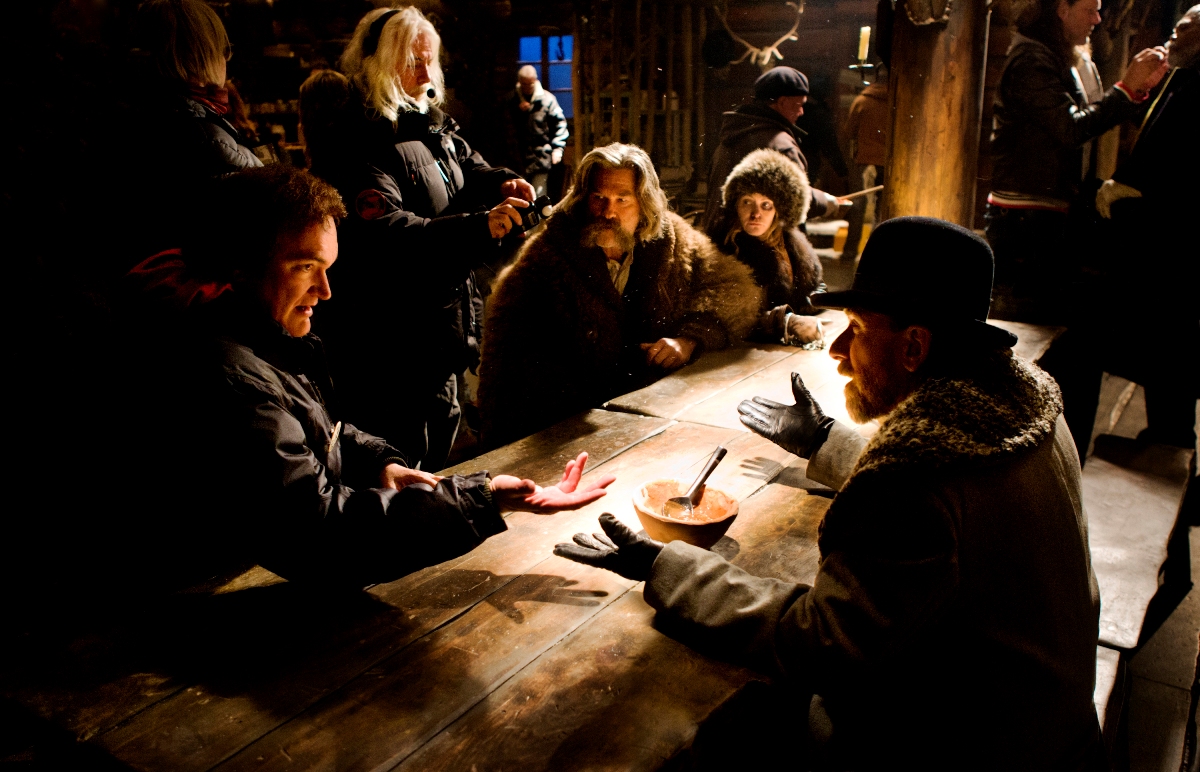 HULLFISH: Tarantino uses a lot of very long scenes – I think of a typical feature film scene as being about 90 seconds – maybe as long as 3 or 4 minutes. But Tarantino was going double that length or more on many scenes. Is there a difficulty in cutting such long scenes?
HULLFISH: Tarantino uses a lot of very long scenes – I think of a typical feature film scene as being about 90 seconds – maybe as long as 3 or 4 minutes. But Tarantino was going double that length or more on many scenes. Is there a difficulty in cutting such long scenes?
RASKIN: I don’t think it makes it harder to edit, I think it gives the scene more of flow. You are absolutely right, there were a total of 57 scenes in this movie. I feel like the average movie has something in the realm of like 200. This is obviously also longer than most movies. It was true of “Django” also. But the scenes have a beginning, a middle and an end.
HULLFISH: I was just considering organizing them and prepping them. With long scenes, it’s harder to compartmentalize the editorial organization. To do the math, a 3 hour 2 minute movie being broken into 57 scenes means each scene in “Hateful Eight” averages more than 3 minutes. I don’t have industry numbers, but “War Room,” which I co-edited, was 197 scenes for a 2 hour movie, or about a half a minute per scene.
RASKIN: Organizing them was a bit of a challenge. Certainly with a longer scene, I’d usually have something like seven or eight bins per scene and there’d be one shot in my first bin that would cover the material from the beginning to the end, so I could keep jumping back to that as I got into coverage. As you’re working through the material, the most important thing is that you watch all the dailies and you just become familiar with where everything is and once you have a handle on it, it’s no different than anything else. You just have a lot more material to go through.
the-hateful-eight-HatefulEight_Clip_FrontierJustice_h264_hd from Steve Hullfish on Vimeo.
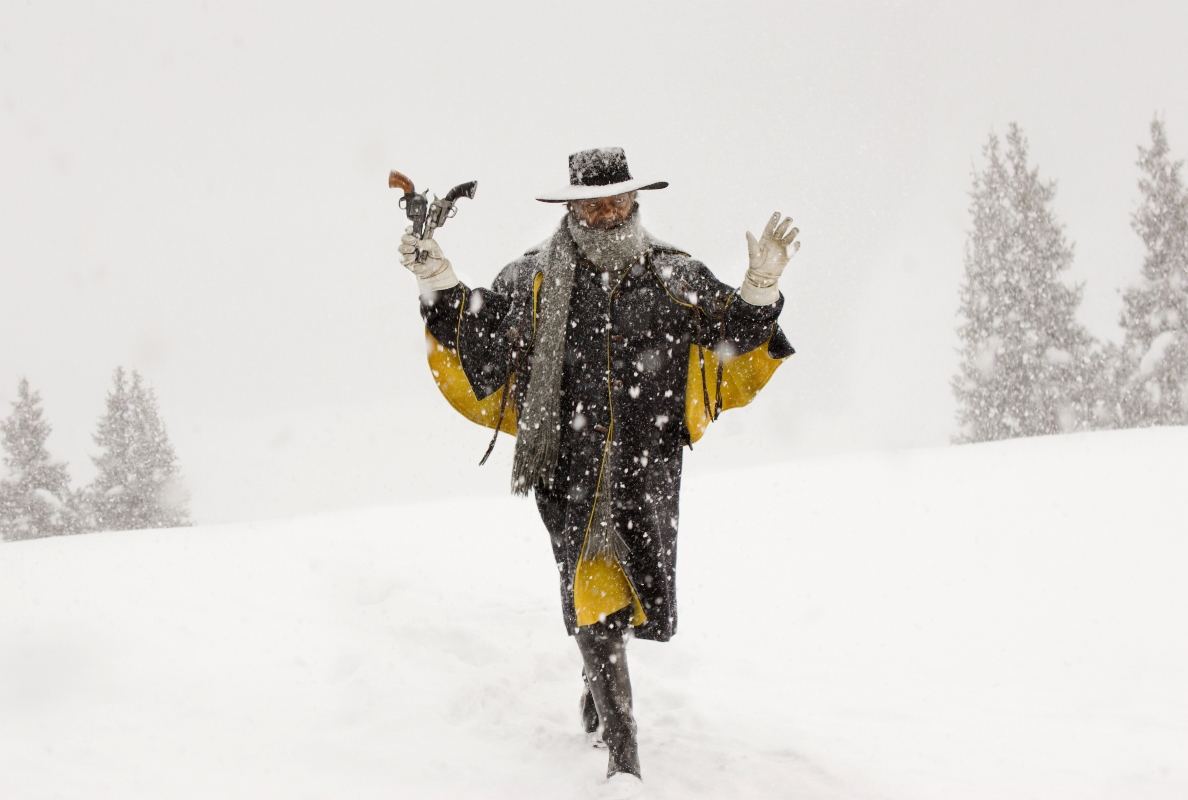 HULLFISH: How do your assistants prepare the movie for you? How do you like it prepared? The dailies come in and…
HULLFISH: How do your assistants prepare the movie for you? How do you like it prepared? The dailies come in and…
RASKIN: They do a few things. Number one, obviously, they make sure that everything is in sync and that includes off-speed material. As you’ve seen from the movie, there is some slow motion stuff where the dialogue is in sync. And so it was up to them to figure out how to re-speed the audio to get it to match and then I have a particular bin set-up that I like that basically allows me to see the way the scene will play out visually right in front of me. I’ll start out with wide shots and then, for example, if it’s a dialogue scene between two characters, I’ll have one character’s dialogue on the left side of the bin and the other’s on the right. And going down from wides, to mediums to tights. And so I can just kind of look at the bin and get a pretty good sense of how this scene is going to play out. When we get into more complex camera moves, then it becomes a little more about making sure these bins follow the order of the shots as lined in the script.
the-hateful-eight-HatefulEight_Clip_EverybodysGotAMother_h264_hd from Steve Hullfish on Vimeo.
HULLFISH: Can you tell me about your approach to cutting a scene? Let’s just say a simple dialogue scene. Then what’s your approach to marking up the shots or creating selects reels or getting to a final edit?
SELECT “NEXT” BELOW TO CONTINUE READING
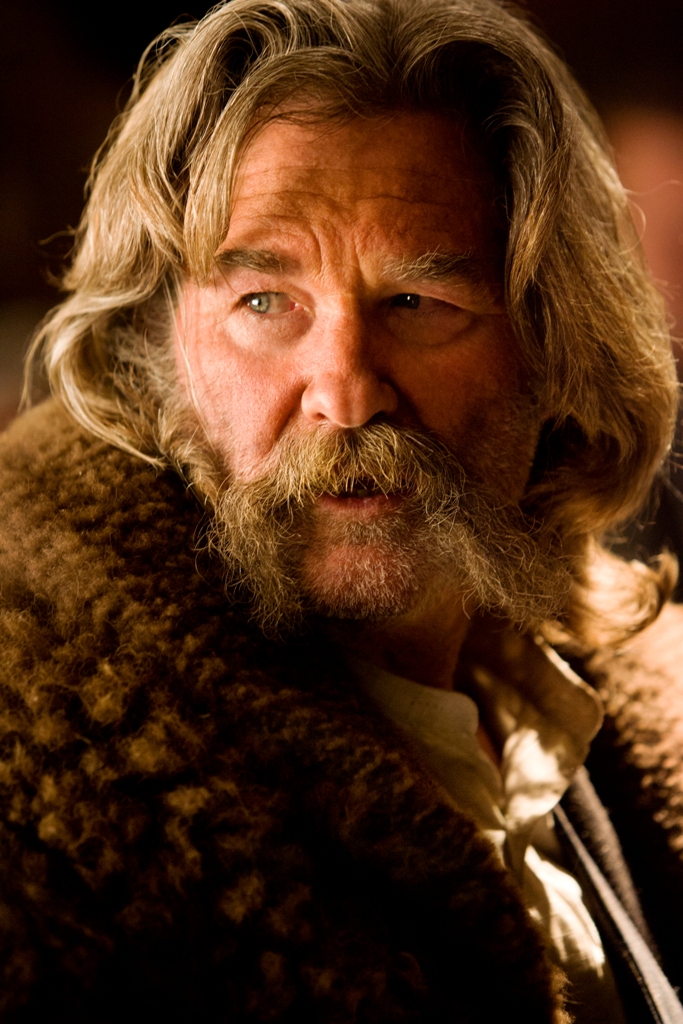 RASKIN: I’ve never done selects reels. I generally will put a marker on any moment where Quentin mentions in dailies. Like if he turns to me and says, “I really like that performance there.” Or if he simply laughs while we’re screening dailies, I’ll know that’s a moment he really likes. I make sure to mark all of those up. And then I just watch the material, and truthfully, I’ll spend a few hours watching the dailies he shot. He probably shoots about an hour and a half’s material per day. He only shoots with one camera, so it’s not an unreasonable amount of material, but obviously when you have a lot of takes of a long scene, it can become a big job to watch all of the material and find your favorite moments. I figure out how I’m going to start the scene and then I just go in and start working with all of the material and kind of going with my gut. Obviously I’ll have seen specific moments when I was watching the dailies and I see “Oh, this HAS to play on THIS shot because it’s so effective there, so I’ll work toward getting that to happen. But it’s really a process of just going with my gut and I won’t stop until I’m truly happy with it and of course, you have to add sound effects. Quentin does not have me edit with music because he has very specific ideas in mind in regards to the music and doesn’t want to have temp music I’ve placed take him out of a scene. So it presented another challenge in that frequently the music can save you and I didn’t have that. I had to deal just with production tracks (what was recorded on set) and sound effects to make everything work. The nice thing about the post-production process is that we have the freedom to make mistakes. We have the freedom to try things. If I do something that’s not to Quentin’s liking, we can always fix it together. And one of the nice things about working on his movies is that he encourages that type of thinking, like “Let’s try something that’s a little out of the box” and that’s what makes his movies so unique.
RASKIN: I’ve never done selects reels. I generally will put a marker on any moment where Quentin mentions in dailies. Like if he turns to me and says, “I really like that performance there.” Or if he simply laughs while we’re screening dailies, I’ll know that’s a moment he really likes. I make sure to mark all of those up. And then I just watch the material, and truthfully, I’ll spend a few hours watching the dailies he shot. He probably shoots about an hour and a half’s material per day. He only shoots with one camera, so it’s not an unreasonable amount of material, but obviously when you have a lot of takes of a long scene, it can become a big job to watch all of the material and find your favorite moments. I figure out how I’m going to start the scene and then I just go in and start working with all of the material and kind of going with my gut. Obviously I’ll have seen specific moments when I was watching the dailies and I see “Oh, this HAS to play on THIS shot because it’s so effective there, so I’ll work toward getting that to happen. But it’s really a process of just going with my gut and I won’t stop until I’m truly happy with it and of course, you have to add sound effects. Quentin does not have me edit with music because he has very specific ideas in mind in regards to the music and doesn’t want to have temp music I’ve placed take him out of a scene. So it presented another challenge in that frequently the music can save you and I didn’t have that. I had to deal just with production tracks (what was recorded on set) and sound effects to make everything work. The nice thing about the post-production process is that we have the freedom to make mistakes. We have the freedom to try things. If I do something that’s not to Quentin’s liking, we can always fix it together. And one of the nice things about working on his movies is that he encourages that type of thinking, like “Let’s try something that’s a little out of the box” and that’s what makes his movies so unique.
the-hateful-eight-H8_EPK_SelectBRoll_Part1of2_h264_hd from Steve Hullfish on Vimeo.
HULLFISH: Tell me about the manipulation of time as an editor. You often skipped or jumped in time, like after the bodies have been loaded on the stagecoach in the opening scene, but then immediately, you slow down and draw out time with the slo-mo footage of the horses and the long, long shot of the crucified, snowy Christ on the cross.
RASKIN: In the final chapter of the movie the way the slow-motion dialogue interacts with the regular dialogue? We’d had my assistants sync up the material including the slow-motion material so the voices would go in slow-motion, too. And that’s how Quentin watched the dailies. And he called me up and said “I was watching dailies last night and I had this idea: You know how in a Sam Peckinpah movie the hero’s moving in regular speed and they’re shooting and a guy will get shot in slow-mo and he’ll move a little and they go back to the hero then back to the slow-mo guy? What if we did that with the DIALOGUE?” And I said, “I don’t think I’ve ever seen that done before, but I am absolutely thrilled to give it a shot.” So we tried it with that sequence and just loved how it played out. It’s so unique to Quentin. Only he could get away with trying something like that. His movies are so idiosyncratic that it feels perfectly of a piece. We just found ourselves laughing as we were doing it, so we felt like we were on the right track.
HULLFISH: Talk to me about performance… choosing performances, and also letting great performances dictate the pacing of your edits – there’s a beautifully held shot of Daisy in the stagecoach as she looks at Samuel Jackson’s character. (This clip from the movie isn’t the shot I’m talking about, but it’s the same scene.)
the-hateful-eight-HatefulEight_Clip_TheHangmanLong_h264_hd from Steve Hullfish on Vimeo.
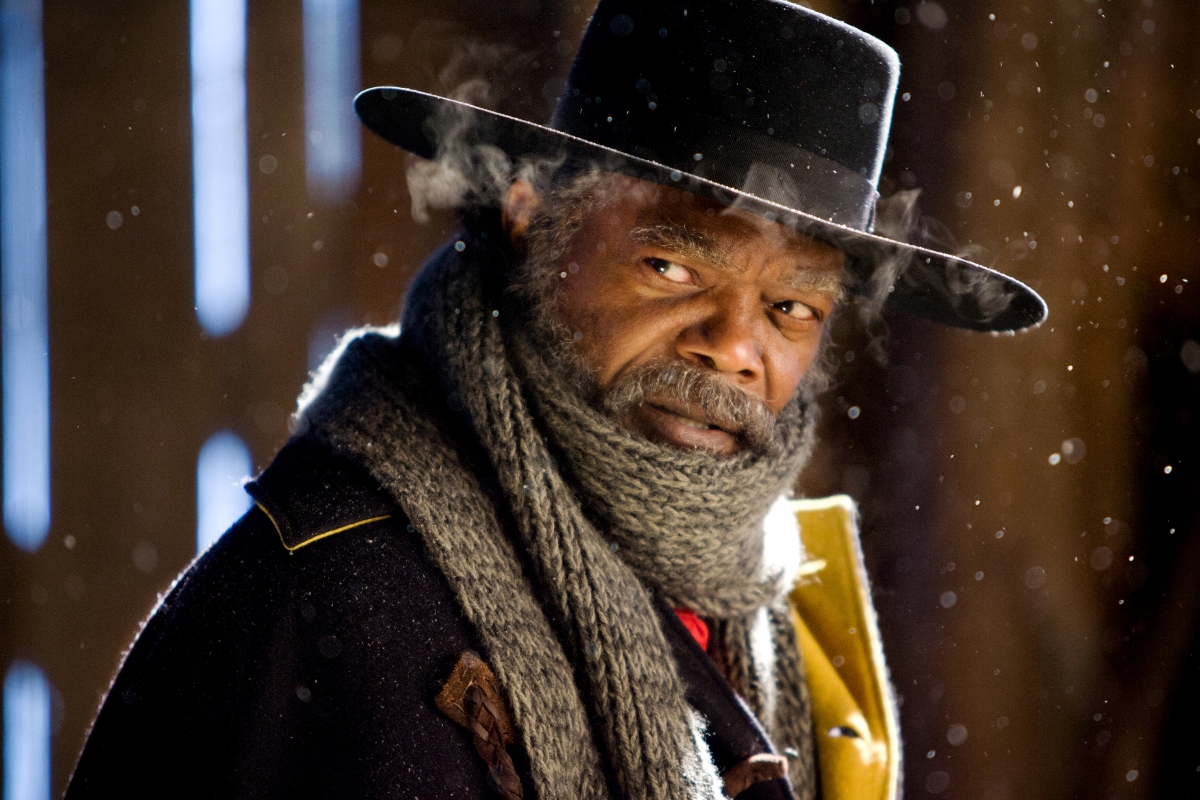 RASKIN: That particular one I can’t take any credit for. That’s all Quentin. He directed these amazing performances. And in that particular example, early on in the movie, if the movie’s really doing its job, at first we’re supposed to feel some sympathy for Daisy. She’s getting roughed up through the first part of the movie and we’re supposed to feel bad for her and that particular moment really puts us in her head. Obviously, if the movie is doing its job, by the end of the movie, we’re rooting against her. I think the sequences themselves dictate how they’re going to be edited. Probably the best example I can give is the sequence that ends the first act of the movie where Major Warren tells Smithers what happened to his son. The shots are very specific to not show anyone other than Major Warren, General Smithers or Chris Mannix. I don’t think you’re fully aware at the time that that’s what’s happening, but you understand later on in the movie why that was done.
RASKIN: That particular one I can’t take any credit for. That’s all Quentin. He directed these amazing performances. And in that particular example, early on in the movie, if the movie’s really doing its job, at first we’re supposed to feel some sympathy for Daisy. She’s getting roughed up through the first part of the movie and we’re supposed to feel bad for her and that particular moment really puts us in her head. Obviously, if the movie is doing its job, by the end of the movie, we’re rooting against her. I think the sequences themselves dictate how they’re going to be edited. Probably the best example I can give is the sequence that ends the first act of the movie where Major Warren tells Smithers what happened to his son. The shots are very specific to not show anyone other than Major Warren, General Smithers or Chris Mannix. I don’t think you’re fully aware at the time that that’s what’s happening, but you understand later on in the movie why that was done.
HULLFISH: Talk to me about some of the long edits – there’s one where Samuel Jackson’s character describes his prison escape.
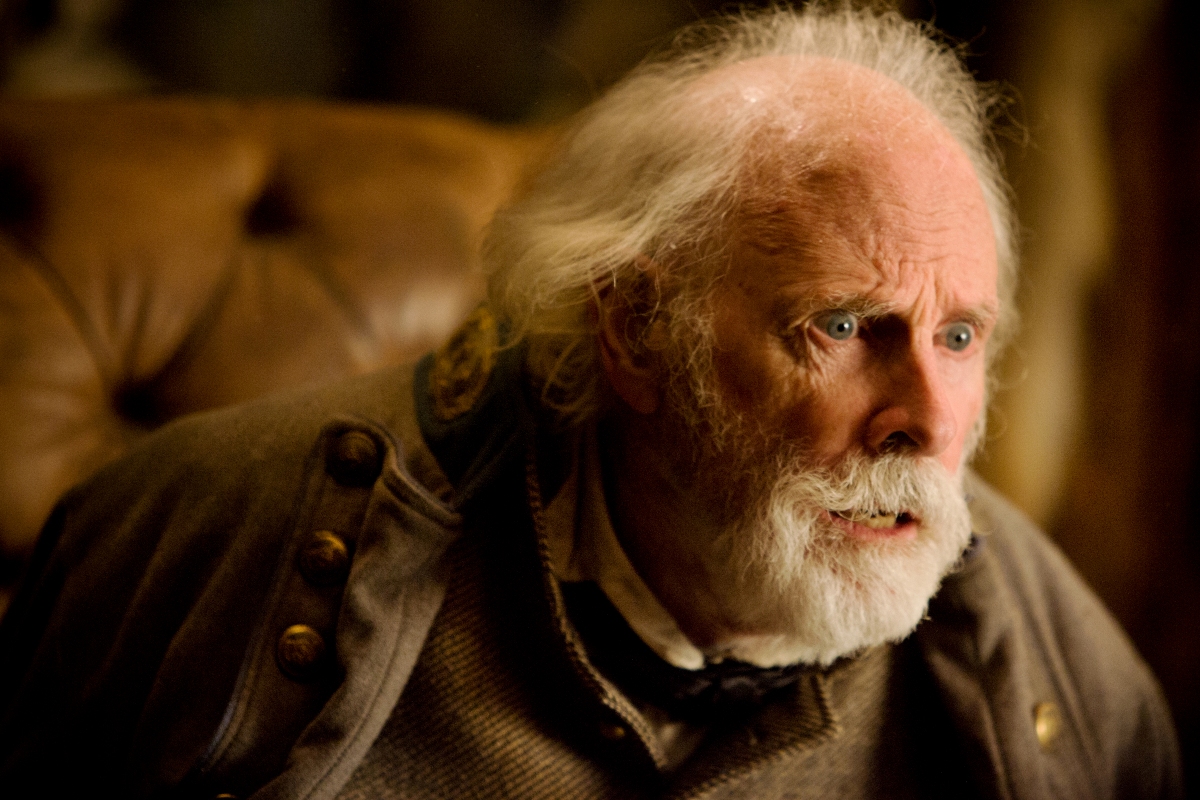 RASKIN: That particular moment has a really neat sonic idea that is in the screenplay that as he’s telling the story, we hear the sound of the prison burning down and the people screaming and the horses screaming. It comes in to the soundtrack as the story’s being told and then we get yanked back to reality at the end of it. Quentin gets these great performances out of these terrific actors. Why would you ever want to cut away if you didn’t need to. In general, Quentin’s style is to hold on whatever actor is speaking. He likes to say that in this movie, there are more reaction shots than in all the other movies he’s done put together, because so much of this movie is contingent is on the mystery of – we don’t know where any one character is coming from. We don’t know what anyone’s true motivations are. Most of these characters are lying at various points in the movie and the use of the reaction shots is designed to create suspicion in the audience and sometimes exonerate some of the characters as far as the audience is concerned, so there are very specific reasons for those reactions. It’s all about building up the mystery that presents itself in the second act of the movie.
RASKIN: That particular moment has a really neat sonic idea that is in the screenplay that as he’s telling the story, we hear the sound of the prison burning down and the people screaming and the horses screaming. It comes in to the soundtrack as the story’s being told and then we get yanked back to reality at the end of it. Quentin gets these great performances out of these terrific actors. Why would you ever want to cut away if you didn’t need to. In general, Quentin’s style is to hold on whatever actor is speaking. He likes to say that in this movie, there are more reaction shots than in all the other movies he’s done put together, because so much of this movie is contingent is on the mystery of – we don’t know where any one character is coming from. We don’t know what anyone’s true motivations are. Most of these characters are lying at various points in the movie and the use of the reaction shots is designed to create suspicion in the audience and sometimes exonerate some of the characters as far as the audience is concerned, so there are very specific reasons for those reactions. It’s all about building up the mystery that presents itself in the second act of the movie.
HULLFISH: Were there any structural changes in the movie that were made in the editing room?
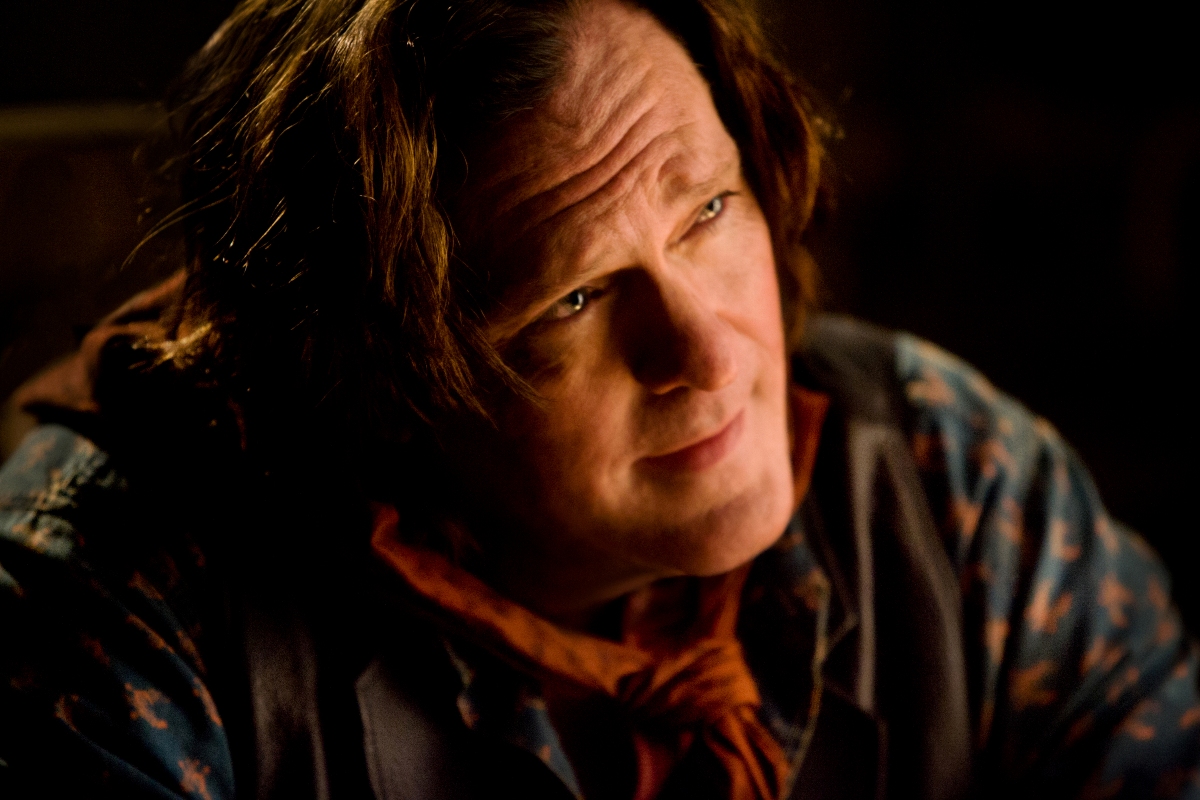 RASKIN: The movie, as it plays out in regards to the intermission and what follows is as it was scripted. But one of the big structural change we tried was in regards to what happens during the conversation between Major Warren and General Smithers. We tried revealing what happens in the background during the conversation as a way to entice the audience and give them an idea of what’s in store in Act Two, similar to the intermission in “2001: A Space Odyssey” does, when we can see that HAL is reading their lips, the audience says, “Oh no. What’s happening here?” So it was an intriguing idea to forecast that major event in the second act, and we actually conformed the 70mm work picture and watched the whole movie projected like that. But we found that while, to a degree, it does intrigue you to see what’s going to happen next, it also diluted the impact of the scene between Major Warren and General Smithers. And we felt that the intermission comes at such a perfect point and has such a great impact that we didn’t want to dilute that. So we were glad that we tried that experiment, but now we can feel like we’re a hundred percent confident that the way it was scripted was the way it should be.
RASKIN: The movie, as it plays out in regards to the intermission and what follows is as it was scripted. But one of the big structural change we tried was in regards to what happens during the conversation between Major Warren and General Smithers. We tried revealing what happens in the background during the conversation as a way to entice the audience and give them an idea of what’s in store in Act Two, similar to the intermission in “2001: A Space Odyssey” does, when we can see that HAL is reading their lips, the audience says, “Oh no. What’s happening here?” So it was an intriguing idea to forecast that major event in the second act, and we actually conformed the 70mm work picture and watched the whole movie projected like that. But we found that while, to a degree, it does intrigue you to see what’s going to happen next, it also diluted the impact of the scene between Major Warren and General Smithers. And we felt that the intermission comes at such a perfect point and has such a great impact that we didn’t want to dilute that. So we were glad that we tried that experiment, but now we can feel like we’re a hundred percent confident that the way it was scripted was the way it should be.
HULLFISH: Editing in Avid?
RASKIN: Yes.
HULLFISH: How much sound design are you doing as you deliver early cuts?
the-hateful-eight-H8_EPK_SelectBRoll_Part2of2_h264_hd from Steve Hullfish on Vimeo.
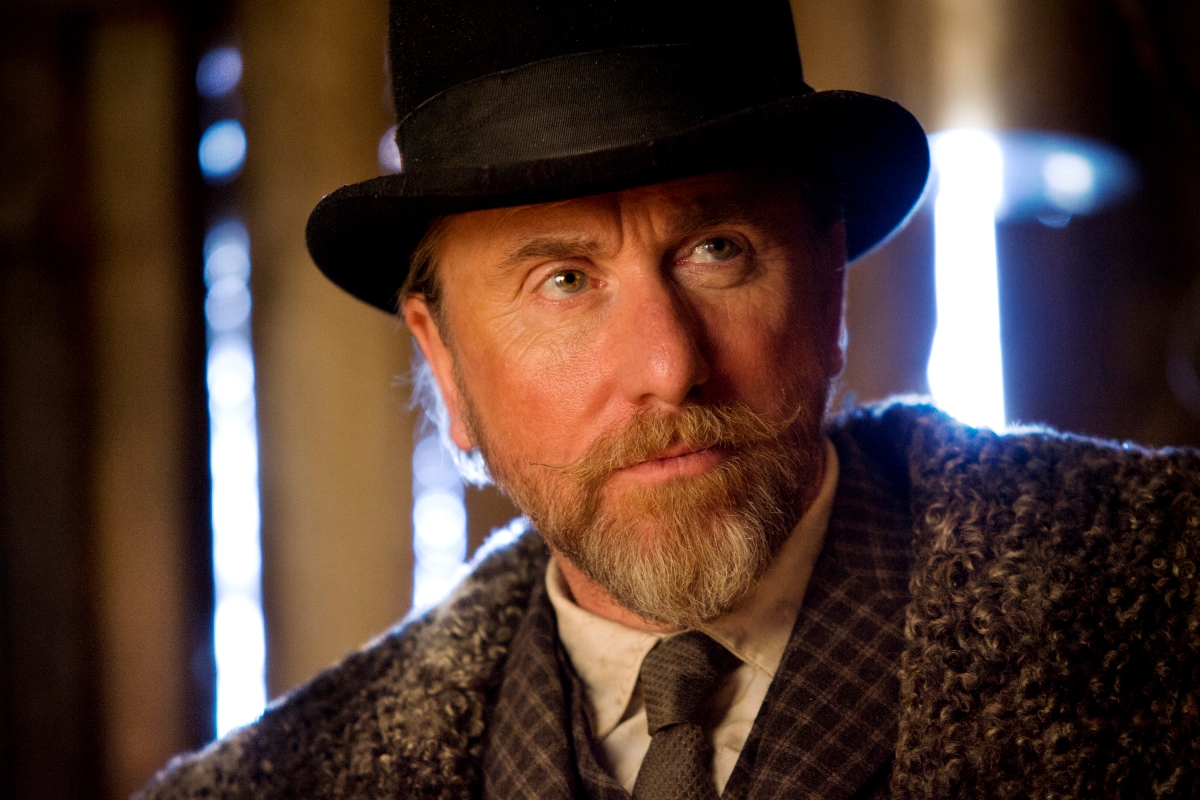 RASKIN: Extensive. I just normally do extensive sound design, regardless because I can’t accurately judge how my cuts are working without having background and full sound effects in there. Having said that, that even during the “Kill Bill” days, that Quentin and – truthfully, myself also – were very susceptible to temp lock. The more we hear something the more we like how it sounds, the more we become married to it. So something that I did on both “Django” and this movie is that the moment we finished a sequence, I would have my assistants ship it off to Wiley Statemen and Harry Cohen, our supervising sound editors and do a full-on sound design pass and get me LCR tracks that I could bring in to the Avid as a full mix. So the material we were falling in love with was coming from the sound guys and was representative of what we were ultimately going to come up with. So we were falling in love with the right stuff instead of the library effects that I’ve been using for ten years.
RASKIN: Extensive. I just normally do extensive sound design, regardless because I can’t accurately judge how my cuts are working without having background and full sound effects in there. Having said that, that even during the “Kill Bill” days, that Quentin and – truthfully, myself also – were very susceptible to temp lock. The more we hear something the more we like how it sounds, the more we become married to it. So something that I did on both “Django” and this movie is that the moment we finished a sequence, I would have my assistants ship it off to Wiley Statemen and Harry Cohen, our supervising sound editors and do a full-on sound design pass and get me LCR tracks that I could bring in to the Avid as a full mix. So the material we were falling in love with was coming from the sound guys and was representative of what we were ultimately going to come up with. So we were falling in love with the right stuff instead of the library effects that I’ve been using for ten years.
HULLFISH: I wish we could continue this conversation, but I know you’re in the middle of press junket interviews and my time is unfortunately at an end. Thanks so much for your time discussing this project.
RASKIN: Thanks. I enjoyed it.
If you’d like to read more interviews with some of the top editors in the world, please check out THIS LINK and follow me on Twitter at @stevehullfish

Filmtools
Filmmakers go-to destination for pre-production, production & post production equipment!
Shop Now